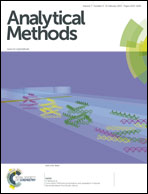Simultaneous determination of dopamine, ascorbic acid and uric acid using a multi-walled carbon nanotube and reduced graphene oxide hybrid functionalized by PAMAM and Au nanoparticles
Abstract
A nanohybrid based on reduced graphene oxide functionalized by poly(amido-amine), multi-walled carbon nanotubes and Au nanoparticles (RGO–PAMAM–MWCNT–AuNPs) for simultaneous electrochemical determination of ascorbic acid (AA), dopamine (DA) and uric acid (UA) was reported in this paper. The RGO–PAMAM–MWCNT–AuNP-modified electrode showed a high selectivity towards the oxidation of AA, DA, and UA, and resolved their overlapped oxidation peaks into three well-defined peaks. The RGO–PAMAM–MWCNT–AuNP nanohybrids were characterized by scanning electron microscopy (SEM). Several important parameters that control the performance of the electrochemical sensor were investigated and optimized. Under optimal conditions by a differential pulse voltammetry (DPV) method, the linear response ranges for the determination of AA, DA, and UA are 20 μM to 1.8 mM, 10 μM to 0.32 mM, and 1 μM to 0.114 mM in the co-existence systems, respectively. The corresponding detection limits are 6.7 μM, 3.3 μM and 0.33 μM (S/N = 3), respectively.


 Please wait while we load your content...
Please wait while we load your content...